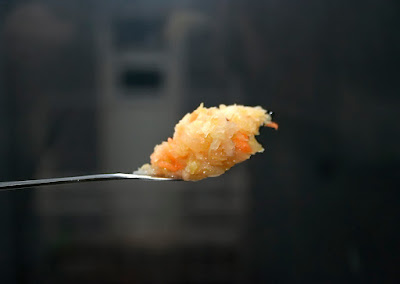 Forecasts promise -11°C for New Year's Eve and I'm making ice cream! Yeap, I know that sounds idiotic but I just bought a pile of Christmas presents for myself, including a cook book about tofu. It made me realize you can make ice cream from soft tofu so I had to try. Of course I knew puréed tofu gives soups and smoothies a fantastic silky structure but somehow I had previously assumed you'd need cream to make ice cream.
Forecasts promise -11°C for New Year's Eve and I'm making ice cream! Yeap, I know that sounds idiotic but I just bought a pile of Christmas presents for myself, including a cook book about tofu. It made me realize you can make ice cream from soft tofu so I had to try. Of course I knew puréed tofu gives soups and smoothies a fantastic silky structure but somehow I had previously assumed you'd need cream to make ice cream.First I thought I'd use glögi spices but then those more ethereal flavours drove over. There's no point in repeating the same things you have in the gingerbread crumbles. Think this is a wonderful dessert option for all those heavy chocolate boxes everyone has lying on the table this time of the year. And actually, a pretty healthy one as well.
The name refers to a book of Tove Jansson where Moomintroll wakes up in the middle of his hibernation, feeling all cold and alone. I can so relate to that. I'm almost certain that I ought to hibernate during wintertime but the society forces be to stay up.
- 200 g lingonberries
- 3 tablespoons lingonberry jam
- 400 g soft tofu (If you're making hemp tofu for this just forget the pressing part.)
- 3 dl gingerbread crumbs (The lovers of the unbaked paste can try rolling small balls out of raw gingerbread.)
- heather flowers
- lavender flowers (Just a hint since their scent unfortunately associates with perfume and you wouldn't want to eat perfume. It's the same problem with spearmint and tooth paste.)
Leave the frozen berries on the table for a moment to soften them up enough so you can crush them. Whip everything but the gingerbread crumbs together and stick the bowl into freezer. (Don't press the tofu even if you normally would.) Stir occasionally to break down any forming ice crystals. When you start to have hard time with the stirring (after about five hours) throw in the gingerbread crumbs and freeze one more hour. Serve with a hot drink.
The freezing of tofu ice cream seemed to be taking longer than normally and then again, it seemed to freeze really thoroughly. (This may be just due to the berries.) So thoroughly that if you don't eat it right away you have to leave it on the table for about an hour before serving in order to scoop anything out of it. The partly frosted, partly melted structure on the other hand is just heavenly.
Nutritional values / 690 g:
energy 512 kcal
fat 16 g
protein 25 g
carbohydrates 66 g
fiber 16 g





































